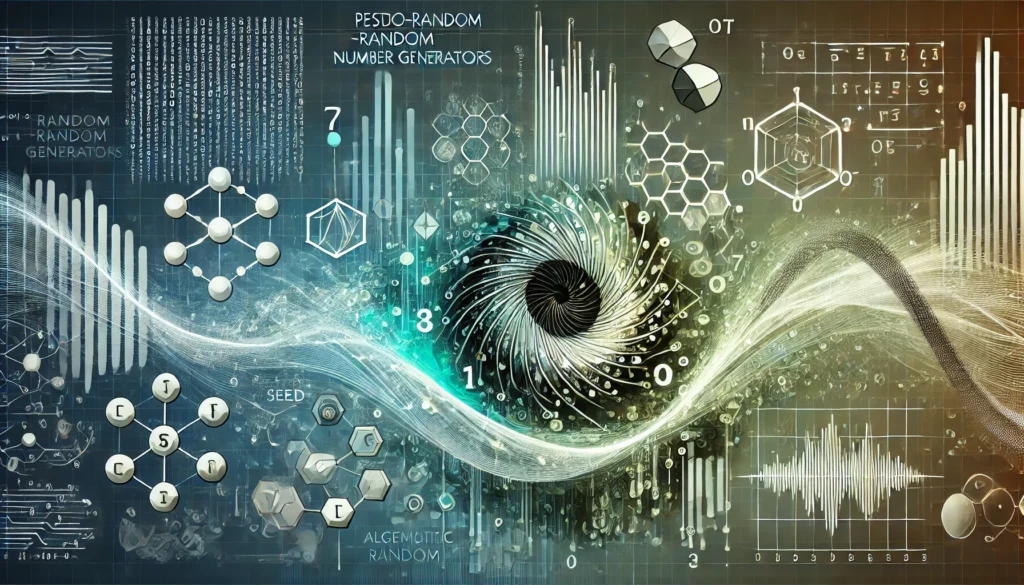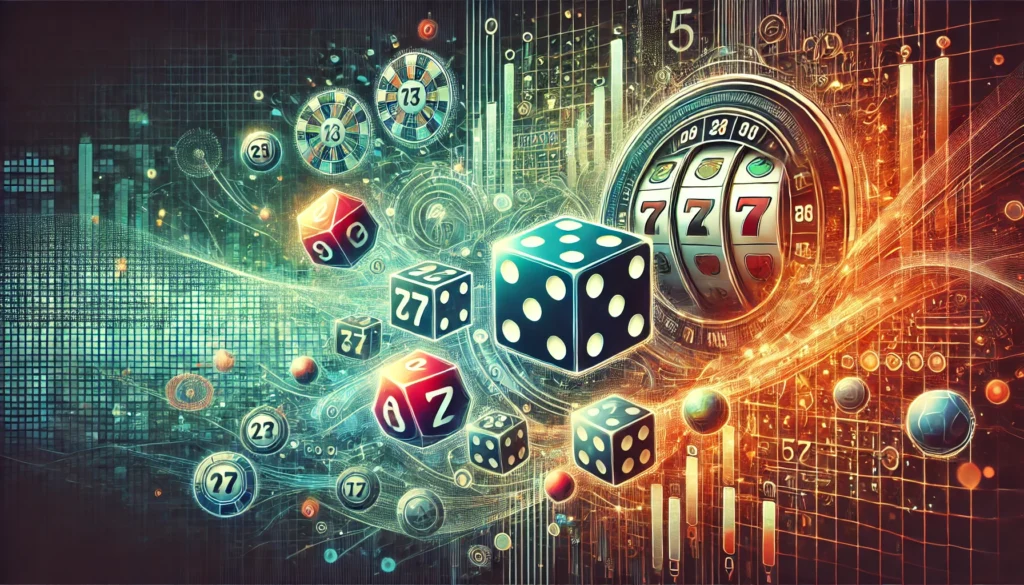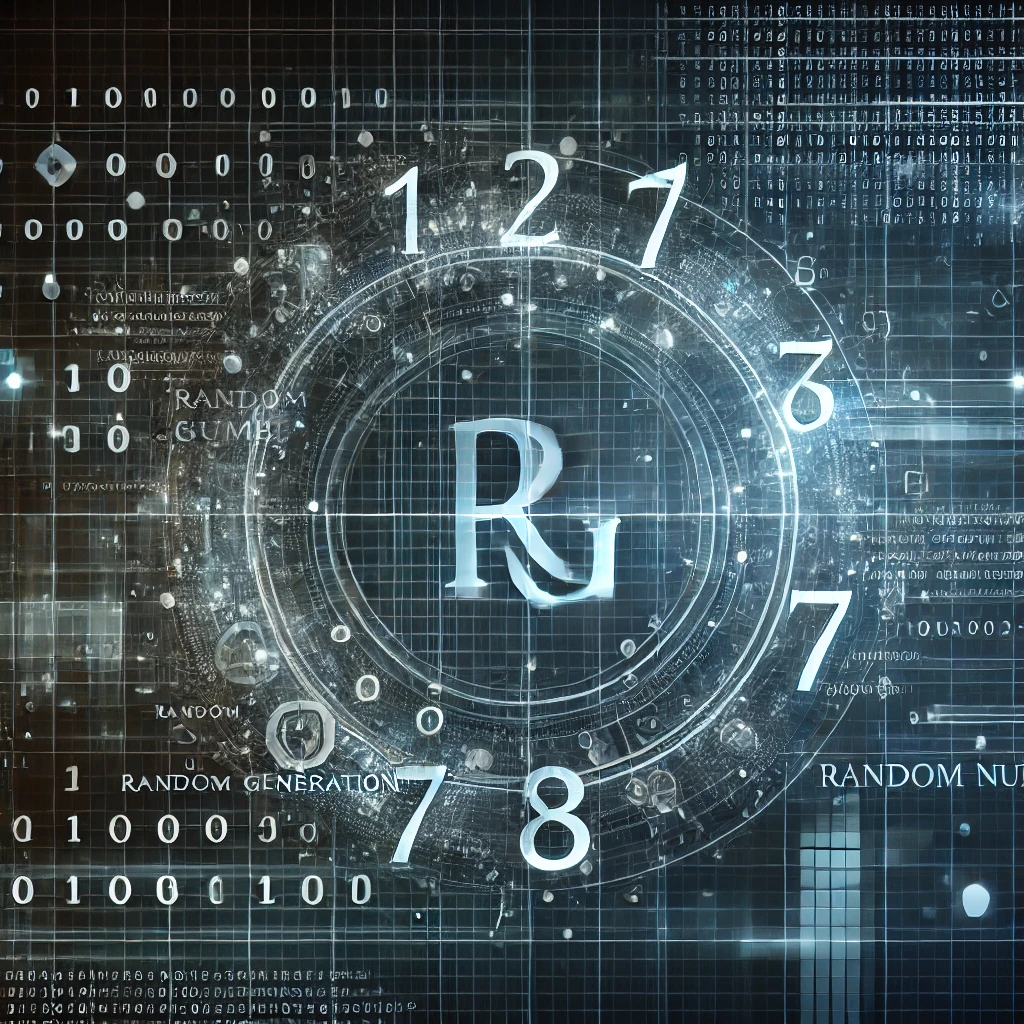Introduction to Random Number Generation
Random numbers are a crucial aspect of computing and mathematics, playing a foundational role in a wide range of applications that affect our daily lives. Whether you’re encrypting data for secure communication, simulating weather patterns, or playing a video game, random number generation (RNG) is often quietly working behind the scenes to make everything possible.
In the digital world, randomness is not always as simple as rolling a die or flipping a coin. Computers, being inherently deterministic machines, cannot generate true randomness without relying on external physical phenomena or highly sophisticated algorithms. Yet, despite these challenges, RNG is indispensable for fields such as cryptography, gaming, simulations, and statistical modeling. Its importance has only grown as technology becomes more intertwined with everyday activities and innovations like blockchain and artificial intelligence advance.
This guide aims to demystify the world of RNG by explaining what it is, how it works, the different types of RNGs, and how they are used across various industries. By the end of this article, you’ll have a thorough understanding of random number generation, its real-world applications, and emerging trends shaping the future of this fascinating technology.
What is RNG?
Random Number Generation, or RNG, refers to the process of generating a sequence of numbers or symbols that cannot be predicted better than by random chance. In simpler terms, it’s the creation of unpredictable and unbiased numbers.
There are countless scenarios in which randomness is essential. A random number generator ensures that the results of actions, such as selecting lottery numbers, encrypting data, or creating procedural game environments, are unpredictable and varied. However, achieving true randomness in the computational realm isn’t as straightforward as it might seem.
In the context of computing, RNG is about creating numbers that seem random but are often generated through an algorithm. When these numbers are generated algorithmically, we call this pseudo-random number generation. On the other hand, True RNG (TRNG) relies on physical processes, such as radioactive decay or thermal noise, which are inherently unpredictable.
While both types of RNG are useful in different scenarios, each has its limitations and strengths. The quest for perfect randomness is a complex endeavor, especially when the outcome directly impacts sensitive areas such as security and data protection.
In daily life, randomness can be observed through various means, such as flipping a coin, rolling dice, or shuffling cards. These activities produce unpredictable results, which are easy for humans to interpret as random. However, achieving similar outcomes through machines is far more difficult, requiring specialized techniques.
Brief History and Evolution of RNG
The concept of randomness and generating random numbers has ancient roots. Early civilizations used physical objects like dice, coins, and cards to introduce chance and randomness into games, decision-making, and even divination. These basic tools provided randomness by relying on natural physics. For example, a dice roll’s outcome depends on factors such as the force applied and the environment in which it’s rolled, which are difficult to predict and therefore random in practice.
Mechanical and Early Computational RNG
As technology evolved, humans sought new ways to produce randomness beyond relying on manual methods. One of the earliest mechanical devices for generating random numbers was developed by Francis Galton, a 19th-century scientist, who created a machine that used a mix of balls and pegs to produce seemingly random outcomes. These early attempts were effective for small-scale uses but couldn’t generate the large quantities of random numbers required for more complex operations.
The need for random numbers surged with the development of digital computing during the 20th century. Early computers relied on tables of random numbers manually produced and printed in books, such as the famous “RAND Corporation’s Book of Random Numbers.” This method was time-consuming and impractical for many tasks.
The Digital Age: Pseudo-Random Number Generators (PRNG)
With the advent of electronic computers, researchers began developing algorithms that could automatically generate random numbers. These numbers weren’t truly random but followed predictable sequences based on an initial “seed” value, making them pseudo-random. The key advantage of pseudo-random number generators (PRNG) is their ability to generate large amounts of random numbers quickly, which became essential for simulations, gaming, and later, cryptography.
One of the most influential algorithms to come from this period is the Mersenne Twister, developed in 1997 by Makoto Matsumoto and Takuji Nishimura. This algorithm is widely used today due to its long period (the number of iterations before the sequence repeats), making it suitable for many applications that don’t require high levels of security. PRNGs, while convenient, have limitations due to their inherent predictability, which can be problematic for security-sensitive operations like cryptography.
True Random Number Generators (TRNG)
As technology advanced, the demand for true randomness, particularly in fields like cryptography, led to the development of True Random Number Generators (TRNGs). Unlike PRNGs, which rely on mathematical formulas, TRNGs derive randomness from physical phenomena that are inherently unpredictable. For instance, a TRNG might measure radioactive decay or electronic noise in a circuit to generate random values. Since these physical processes are governed by the laws of quantum mechanics, they offer a higher level of randomness compared to PRNGs.

The development of TRNGs marked a significant advancement in RNG technology, especially in areas where security and unpredictability are crucial. Today, TRNGs are commonly used in applications such as encryption key generation, where true randomness is vital for maintaining security.
Current State of RNG
RNG technology has come a long way since the days of rolling dice or flipping coins. Today, RNG is deeply embedded in various aspects of computing, from simple simulations to complex cryptographic protocols. As computing power continues to grow and applications for randomness expand, the evolution of RNG remains a critical area of research.
Types of Random Number Generators
Random number generators (RNGs) can be broadly classified into two main types: True Random Number Generators (TRNGs) and Pseudo-Random Number Generators (PRNGs). Each of these types has different methods, advantages, and limitations depending on how randomness is produced and the context in which they are used.
True Random Number Generators (TRNGs)
True Random Number Generators (TRNGs) are designed to generate numbers based on physical processes that are inherently unpredictable. These generators use external physical phenomena—such as electronic noise, radioactive decay, or quantum effects—as the source of randomness. Since the behavior of these processes cannot be predicted or influenced, TRNGs offer high-quality randomness that is useful for critical applications where predictability can lead to security vulnerabilities.
- How TRNGs Work: TRNGs typically use sensors or specialized hardware to capture random signals from physical phenomena. For example, electronic circuits might measure thermal noise (a form of electrical signal noise that is random), and the output is then processed to produce random numbers. Another method involves capturing random fluctuations in laser beams or cosmic rays.
- Applications of TRNGs: TRNGs are essential in fields like cryptography, where unpredictability is crucial to secure communication and encryption. In generating encryption keys, for instance, the use of true randomness ensures that attackers cannot predict or reproduce the keys, making data breaches significantly more difficult. Similarly, TRNGs are used in secure financial transactions, secure key management systems, and lotteries, where any form of predictability could lead to fraud or manipulation.
- Advantages and Limitations:
- Advantages: TRNGs offer genuine randomness, which makes them highly suitable for applications that require unpredictability. They are resistant to external interference since they rely on physical processes.
- Limitations: TRNGs tend to be slower and more expensive than PRNGs due to the need for specialized hardware. Moreover, they can be influenced by environmental factors like temperature, which might introduce some bias if not properly controlled.
Pseudo-Random Number Generators (PRNGs)
Pseudo-Random Number Generators (PRNGs) differ fundamentally from TRNGs because they rely on algorithms to generate sequences of numbers that only appear random. These algorithms take an initial input, known as a “seed,” and generate a sequence of numbers based on deterministic mathematical formulas. Although the results can resemble randomness, PRNGs are not truly random because the sequence can be reproduced if the seed value is known.
- How PRNGs Work: PRNGs start with a seed value, which is usually a number derived from the system clock or user input, and then apply a mathematical algorithm to generate a sequence of numbers. One of the most widely used PRNG algorithms is the Mersenne Twister, which has a long period before the sequence repeats and is suitable for many general-purpose applications. However, the security of PRNGs depends heavily on the secrecy of the seed. If an attacker can predict or determine the seed, they can potentially reconstruct the entire sequence of numbers.
- Applications of PRNGs: PRNGs are used in many fields where true randomness is not required, such as video games, simulations, procedural content generation, and statistical modeling. For instance, when simulating a physical process in a computer, PRNGs can generate data that behaves similarly to the real-world randomness without needing to measure external physical phenomena.
- Advantages and Limitations:
- Advantages: PRNGs are computationally efficient and can generate large amounts of random data quickly. They are highly portable and can be used in virtually any software system without specialized hardware.
- Limitations: The primary limitation of PRNGs is their predictability. Since they are based on deterministic algorithms, the random sequence can be reconstructed if the seed is known. This makes them unsuitable for high-security applications like cryptography.
Comparison: TRNG vs. PRNG
| Aspect | TRNG | PRNG |
|---|---|---|
| Source of Randomness | Physical phenomena (e.g., thermal noise) | Mathematical algorithms |
| Predictability | Unpredictable | Can be predicted if the seed is known |
| Speed | Slower due to reliance on hardware | Faster, can generate numbers efficiently |
| Cost | More expensive due to specialized hardware | Low-cost, no special hardware required |
| Applications | Cryptography, security-sensitive tasks | Simulations, video games, general computing |
Both TRNGs and PRNGs play crucial roles in modern computing, each suited for different types of applications based on their speed, cost, and predictability. Understanding the differences helps in choosing the right type of RNG for a specific task.
Common Methods of Generating Random Numbers
Generating random numbers, whether through software algorithms or hardware mechanisms, is a complex process. Below, we discuss some of the most common methods used to generate random numbers, focusing on both algorithmic and hardware-based techniques.
Algorithmic RNGs
Algorithmic random number generators rely on mathematical formulas to produce sequences of numbers that resemble randomness. Some of the most widely used algorithms are:
- Mersenne Twister: The Mersenne Twister is one of the most popular PRNG algorithms, known for its long period (2²⁰⁹³⁷-1) before repeating its sequence. It is designed to generate high-quality pseudo-random numbers for simulations, modeling, and other cations where large quantities of random numbers are needed. It offers an excellent balance of speed and randomness but is not suitable for cryptographic applications due to its predictability.

- Linear Congruential Generator (LCG): LCG is a simple and efficient PRNG algorithm that works by applying a linear equation to the current number in the sequence to generate the next number. Despite its simplicity and speed, LCG has limitations in terms of randomness quality and period length, making it less suitable for complex applications.
- Xorshift Algorithm: Xorshift is a family of PRNGs that use bitwise operations (XOR and shift) to generate random numbers. It is computationally efficient and can produce random numbers faster than traditional algorithms like LCG. While suitable for many non-secure applications, it is not ideal for cryptographic use due to its predictable nature when the seed is known.
Hardware-Based RNG (HRNG)
Hardware-based random number generators use physical processes to produce truly random numbers. These RNGs are typically more expensive but offer higher-quality randomness compared to algorithmic RNGs.
- Thermal Noise: One of the most common methods of generating hardware-based random numbers is to capture the inherent electronic noise generated by thermal energy in circuits. This noise, also known as Johnson-Nyquist noise, is unpredictable and can be amplified to produce random numbers. Specialized hardware devices can measure and process this noise to generate true random values.
- Radioactive Decay: Another method used in high-end TRNG systems is the measurement of radioactive decay. The process of radioactive decay is inherently random and cannot be predicted, making it an ideal source of entropy for generating random numbers. However, this method requires specialized and often expensive equipment.
- Quantum-Based RNG (QRNG): Quantum RNGs represent the cutting edge of random number generation technology. Quantum systems are governed by the principles of quantum mechanics, which include inherent unpredictability. For example, the measurement of quantum states or photon emissions can generate truly random numbers. QRNGs are becoming increasingly important for applications requiring high levels of security and precision, such as in quantum cryptography.
Comparison of Methods
| Method | Type | Speed | Applications |
|---|---|---|---|
| Mersenne Twister | Algorithmic (PRNG) | Fast | Simulations, games, non-secure applications |
| LCG | Algorithmic (PRNG) | Very Fast | Basic simulations, procedural generation |
| Xorshift | Algorithmic (PRNG) | Fast | Video games, simulations, non-critical tasks |
| Thermal Noise | Hardware (TRNG) | Slow | Cryptography, secure communications |
| Radioactive Decay | Hardware (TRNG) | Slow | Scientific experiments, high-security tasks |
| Quantum RNG (QRNG) | Hardware (TRNG) | Medium | Quantum cryptography, secure transactions |
Each method has its advantages and trade-offs, depending on the balance needed between speed, randomness quality, and cost. For non-secure applications, PRNGs like the Mersenne Twister are usually sufficient. For high-security environments, hardware-based methods like QRNG are increasingly in demand due to their ability to generate true randomness.
Applications of Random Numbers
Random number generation (RNG) is critical in many industries and disciplines. Its utility spans from cryptography to gaming, simulations, artificial intelligence, and beyond. This section explores the diverse applications of RNG and explains why randomness is fundamental in each area.
Cryptography
One of the most critical applications of RNG is in cryptography, where it is used to secure communications, protect data, and ensure privacy. In cryptographic systems, randomness is essential for generating secure encryption keys, initialization vectors (IVs), and nonces (numbers used only once). Without randomness, these keys or numbers could be predicted, leading to security vulnerabilities.
- Key Generation: Cryptographic algorithms, such as RSA and AES, rely heavily on the randomness of key generation to ensure security. If an attacker can predict the keys or deduce patterns in the random numbers used, they can decrypt sensitive data. For this reason, high-quality RNG, often TRNGs, are used to ensure that the keys are truly unpredictable.
- Digital Signatures: RNG plays a role in creating secure digital signatures, ensuring that the signatures cannot be forged or reused in unauthorized ways. Nonces used in these systems must be truly random to prevent replay attacks or other security breaches.
- Importance of Secure RNG: Poorly implemented PRNGs have led to several high-profile cryptographic failures. For instance, in 2012, a vulnerability in the RNG used by Android’s Java Cryptography Architecture led to predictable key generation, compromising the security of Bitcoin wallets. This incident highlighted the dangers of weak RNG in cryptographic applications.
In cryptography, RNG is not just important—it’s mission-critical. The unpredictability of random numbers directly correlates to the strength and security of cryptographic systems, making secure RNG indispensable.
Simulations and Modeling
Random numbers are a fundamental component of simulations and modeling, particularly in fields that rely on probabilistic systems or need to account for uncertainty. RNG allows these systems to replicate real-world phenomena by introducing variability into the models.
- Monte Carlo Simulations: One of the most well-known applications of RNG in simulations is the Monte Carlo method, a statistical technique used to model complex systems and assess risk or uncertainty. Monte Carlo simulations use random sampling to estimate numerical results for problems that are too complex to solve analytically. This approach is widely used in finance, engineering, and physics. For example, financial analysts use Monte Carlo simulations to predict future market movements, while engineers use them to assess risk in large infrastructure projects.
- Scientific Modeling: In scientific research, simulations powered by RNG help researchers understand processes ranging from atomic interactions to weather patterns. These models rely on randomness to mimic the variability seen in the real world, enabling accurate predictions and experiments.
Gaming and Gambling
In the gaming and gambling industries, RNG plays a central role in ensuring fairness, unpredictability, and excitement. From video games to online casinos, random number generators determine outcomes that should be free from manipulation or bias.
- Video Games: RNG is used in video games to create unpredictable and dynamic gameplay experiences. For instance, procedural content generation in games like Minecraft or No Man’s Sky relies on RNG to create vast, random worlds, ensuring that no two gaming experiences are the same. Additionally, RNG is used to determine random events, loot drops, and AI behavior, making the game experience engaging and variable.
- Online Gambling: RNG is critical in ensuring the fairness of online gambling platforms, including virtual slot machines, poker games, and lotteries. Without RNG, the results of these games could be easily manipulated, leading to unfair or rigged outcomes. Most jurisdictions require online casinos to use certified RNG systems that are regularly audited to ensure fairness and randomness.

Machine Learning and AI
In machine learning and artificial intelligence (AI), random numbers are used for various purposes, from initializing model parameters to implementing stochastic processes in algorithms.
- Initialization of Neural Networks: When training neural networks, randomness is used to initialize the weights of the connections between neurons. This initialization is critical for the learning process, as starting with uniform or predictable weights can cause the network to get stuck in local minima, preventing it from effectively learning.
- Randomness in Stochastic Algorithms: Many machine learning algorithms, such as stochastic gradient descent, rely on randomness to make decisions during the learning process. Stochastic methods introduce variability in the optimization process, helping models escape local minima and find better solutions.
- Random Forests and Ensemble Methods: Randomness is also essential in certain machine learning models, such as random forests or boosting algorithms. These ensemble methods rely on random sampling of data to build multiple models, which are then combined to improve prediction accuracy.
Statistics
RNG plays a crucial role in statistical analysis, particularly in areas such as sampling, hypothesis testing, and experimental design. In these fields, random numbers help ensure that data is collected in a manner that is unbiased and representative of the population.
- Random Sampling: In surveys, polls, and experiments, random sampling is used to select a subset of individuals from a larger population. This ensures that the sample is representative and that the results of the analysis can be generalized to the entire population. Without randomness, there is a risk of bias in the selection process, which can skew results.
- Randomized Controlled Trials: In scientific research, particularly in medicine, randomized controlled trials (RCTs) are the gold standard for testing new treatments or interventions. RNG is used to randomly assign participants to different groups (e.g., treatment vs. control), ensuring that the assignment is unbiased and that the results are reliable.
Challenges and Limitations of RNG
While random number generation is essential in many fields, it comes with its own set of challenges and limitations. Ensuring true randomness, particularly in software-based systems, is difficult. Additionally, there are several security and performance concerns that must be addressed when using RNG in sensitive applications.
Security Concerns with Pseudo-RNGs
Pseudo-RNGs (PRNGs) generate sequences of numbers based on deterministic algorithms, which means that if an attacker knows the seed value or can predict it, they can recreate the sequence. This predictability poses significant security risks, especially in cryptography and security-sensitive applications.
- Predictability: The most significant challenge with PRNGs is that their output can be predicted if the seed is known. For example, if a PRNG is used to generate cryptographic keys and the attacker gains access to the seed, they can recreate the keys and decrypt sensitive information. Several security breaches have occurred because of weak or improperly implemented PRNGs.
- Examples of Security Failures: A famous example is the vulnerability discovered in the Debian version of OpenSSL in 2008. A flawed PRNG implementation resulted in predictable key generation, compromising the security of many systems worldwide. The incident highlighted the importance of ensuring that PRNGs are properly designed and implemented.
Entropy Issues
Entropy refers to the amount of randomness or unpredictability in a system. In the context of RNG, higher entropy means higher randomness. However, both TRNGs and PRNGs can suffer from low entropy, leading to poor-quality random numbers.
- Low Entropy in TRNGs: Even TRNGs, which rely on physical processes, can sometimes generate low-entropy numbers if the physical process used is not sufficiently random or is influenced by external factors. For example, electronic noise can sometimes be affected by temperature changes, reducing the quality of the random numbers generated.
- Entropy in PRNGs: PRNGs rely on a seed value to generate their sequence. If the seed has low entropy (i.e., it is not sufficiently random), the entire sequence of numbers will have lower unpredictability. This is particularly problematic in applications where security is a concern, such as key generation in cryptography.

Hardware vs. Software Trade-offs
There is often a trade-off between using hardware-based RNGs (TRNGs) and software-based RNGs (PRNGs). While TRNGs offer better randomness, they tend to be slower and more expensive due to the need for specialized hardware. On the other hand, PRNGs are faster and more cost-effective but offer less randomness and can be vulnerable to security risks if not properly implemented.
- Performance Concerns: In high-performance applications, such as real-time simulations or video games, using a TRNG may not be feasible due to its slower speed. In these cases, developers often opt for a PRNG, which can generate large amounts of random numbers quickly, albeit at the cost of predictability.
- Cost of Hardware-Based RNGs: TRNGs require specialized hardware components, such as noise generators or quantum-based sensors, which can be expensive. This makes them impractical for many consumer-grade applications, where cost is a significant factor.
Future Trends in RNG Technology
Random number generation is a rapidly evolving field, with new technologies and methods continually emerging to meet the demands of modern computing, security, and scientific research. The future of RNG will be driven by advancements in quantum computing, blockchain technologies, and the need for even more secure and efficient random number generators.
Quantum RNG (QRNG)
One of the most promising areas in RNG technology is the development of Quantum Random Number Generators (QRNGs). Unlike classical TRNGs, which rely on physical processes that can be influenced by external factors, QRNGs leverage the inherent unpredictability of quantum mechanics to generate truly random numbers. Quantum mechanics, by its very nature, is probabilistic, making it a perfect foundation for randomness.
- How QRNGs Work: QRNGs use quantum processes such as photon emissions or quantum state measurements to generate random numbers. For instance, a quantum system can be set up to emit photons randomly in different directions, and the direction of each photon is entirely unpredictable, providing a source of randomness that is theoretically impossible to reproduce or predict.
- Advantages of QRNGs: QRNGs offer superior randomness compared to traditional TRNGs and PRNGs because they exploit the fundamental randomness of the quantum world. Additionally, since quantum processes are unaffected by classical physical interference, QRNGs are less prone to environmental bias. This makes them highly desirable for applications like cryptography, where the need for unpredictability is paramount.
- Real-World Applications: QRNGs are already being used in high-security environments, such as in quantum cryptography protocols for secure communications. Companies like ID Quantique have commercialized QRNGs for applications in secure encryption, online banking, and critical infrastructure protection.
As quantum computing technology matures, QRNGs are likely to become more accessible and affordable, making them a go-to solution for high-quality randomness in many fields, including finance, defense, and even consumer applications.
RNG in Blockchain and Decentralized Technologies
Blockchain technology and decentralized applications (dApps) are also driving innovation in RNG technology. In blockchain systems, randomness is critical for consensus mechanisms, smart contracts, and token generation. However, generating random numbers in decentralized environments presents unique challenges.
- RNG in Consensus Mechanisms: In blockchain networks like Ethereum and Bitcoin, consensus mechanisms such as proof of stake (PoS) and proof of work (PoW) rely on randomness to fairly select validators or miners who will validate transactions and create new blocks. Secure and unpredictable random number generation ensures that these selections cannot be manipulated, maintaining the integrity of the network.
- Smart Contracts: Randomness is also crucial in smart contracts, particularly for decentralized applications (dApps) that involve gaming, lotteries, or auctions. In these cases, fair and unpredictable RNG ensures that outcomes cannot be tampered with by malicious actors. However, because blockchains are transparent and deterministic by nature, generating random numbers on-chain is challenging. Developers must rely on external sources, oracles, or innovative algorithms to provide randomness without compromising security.
- Innovations in Blockchain RNG: Projects like Chainlink VRF (Verifiable Random Function) have emerged to address the challenges of randomness in decentralized environments. Chainlink VRF provides a secure and verifiable source of randomness for smart contracts, ensuring fairness and security while maintaining decentralization. Such innovations are critical as decentralized finance (DeFi) and other blockchain-based applications continue to grow.

RNG in AI and Machine Learning
As artificial intelligence (AI) and machine learning (ML) continue to advance, the demand for efficient and reliable RNG will grow. AI models, particularly deep learning models, rely on randomness in several key areas, from initializing neural networks to performing stochastic processes during training.
- AI Model Initialization: Random initialization of neural network weights is a critical factor in ensuring that machine learning models converge on accurate solutions. Poor randomness in initialization can lead to models getting stuck in local minima, which negatively impacts performance. As AI models become more complex, the need for high-quality RNG will only increase.
- Randomness in AI Algorithms: Many AI algorithms, such as reinforcement learning and genetic algorithms, incorporate random mutations or decisions to explore different solutions. High-quality RNG ensures that these processes are genuinely unpredictable, allowing AI systems to learn and adapt more effectively.
In the future, advancements in RNG technology, particularly QRNGs, could enhance the robustness and efficiency of AI systems by providing higher-quality randomness for training and optimization.
Conclusion and Summary
Random number generation is a cornerstone of modern computing, playing a critical role in everything from cryptography and simulations to gaming and machine learning. As we’ve explored throughout this guide, RNG is not as simple as generating a series of numbers—it’s a complex field with a wide range of applications, methods, and technologies.
- Types of RNG: We’ve seen that RNG can be broadly categorized into two types: True Random Number Generators (TRNGs), which rely on physical phenomena, and Pseudo-Random Number Generators (PRNGs), which use algorithms to simulate randomness. Each type has its strengths and weaknesses, with TRNGs offering high-quality randomness at the cost of speed and expense, while PRNGs are faster but more predictable.
- Common Methods: Methods of generating random numbers range from software-based algorithms like the Mersenne Twister and Linear Congruential Generator to hardware-based methods that capture physical processes like thermal noise or quantum fluctuations. These methods serve different purposes, depending on the level of randomness required and the specific application.
- Applications: RNG is indispensable in fields like cryptography, where it ensures secure key generation and encryption, and simulations, where it helps model complex systems. In gaming and gambling, RNG ensures fairness and unpredictability, while in AI and machine learning, it powers the stochastic processes that enable models to learn.
- Challenges: Despite its importance, RNG comes with challenges. Pseudo-random generators can be predictable, leading to potential security vulnerabilities. Entropy issues can affect both TRNGs and PRNGs, while the trade-offs between speed, cost, and randomness quality must be carefully balanced.
- Future Trends: The future of RNG looks bright, with advancements in Quantum Random Number Generators (QRNGs) offering unparalleled levels of randomness. In addition, blockchain technology is driving the development of secure RNG methods for decentralized applications, while AI and machine learning are pushing the boundaries of what RNG can achieve.
As technology continues to evolve, so too will the methods and applications of RNG. From ensuring the security of cryptographic systems to powering the next generation of AI, RNG will remain a fundamental component of modern computing. By understanding the different types of RNG, the methods used to generate random numbers, and the applications where randomness is essential, we can appreciate the importance of this often-overlooked aspect of technology.
Final Thoughts
Random number generation is an essential, though often invisible, part of the digital infrastructure that supports our modern world. Its evolution from simple physical methods like rolling dice to advanced quantum-based systems reflects the growing need for unpredictability and security in the face of increasingly complex technological challenges. As RNG continues to evolve, it will undoubtedly play a critical role in shaping the future of technology and security.




One thought on “The Ultimate Guide to Random Number Generation: Methods, Applications, and Use Cases”
Comments are closed.